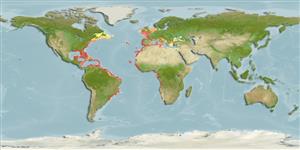Classification / Names
Common names from other countries
Main reference
Size / Weight / Age
Max length : 122 cm TL male/unsexed; (Ref. 26340); common length : 80.0 cm TL male/unsexed; (Ref. 5217); max. published weight: 16.5 kg (Ref. 40637); max. reported age: 10 years (Ref. 28173)
Length at first maturity
Lm 41.8 range ? - 60 cm
Environment
Marine; brackish; reef-associated; oceanodromous (Ref. 51243); depth range 1 - 150 m (Ref. 28173)
Climate / Range
Tropical, preferred 24°C (Ref. 107945); 56°N - 30°S, 92°W - 42°E
Distribution
Atlantic Ocean: in tropical and subtropical waters, including the Mediterranean, Black Sea, Caribbean Sea and Gulf of Mexico. Highly migratory species, Annex I of the 1982 Convention on the Law of the Sea (Ref. 26139).
Countries | FAO areas | Ecosystems | Occurrences | Introductions
Short description
Dorsal
spines
(total): 15 - 16;
Dorsal
soft rays
(total): 11-13;
Anal
spines: 0;
Anal
soft rays: 11 - 15;
Vertebrae: 39. Anterior spines of first dorsal fin much higher than the those mid-way, giving the fin a strongly concave outline. Interpelvic process small and bifid. Body naked except for corselet and lateral line. Swim bladder absent. Incipient protuberances on 33rd and 34th vertebrae. Back with broken oblique stripes (Ref. 168). Caudal peduncle with 7-8 finlets. Dark stripes on the back and with 3-7 dark spots between pelvic and pectoral fins (Ref. 35388).
IUCN Red List Status (Ref. 115185)
Threat to humans
Reports of ciguatera poisoning (Ref. 30303)
Human uses
Fisheries: commercial; gamefish: yes
Tools
Special reports
Download XML
Internet sources
Estimates of some properties based on models
Phylogenetic diversity index
PD50 = 0.6250 many relatives (e.g. carps) 0.5 - 2.0 few relatives (e.g. lungfishes)
Trophic Level
4.5 ±0.0 se; Based on diet studies.
Resilience
Medium, minimum population doubling time 1.4 - 4.4 years (K=0.13-0.22; tm=2; tmax=8; Fec=71,000)
Vulnerability
High vulnerability (57 of 100)
Price category
